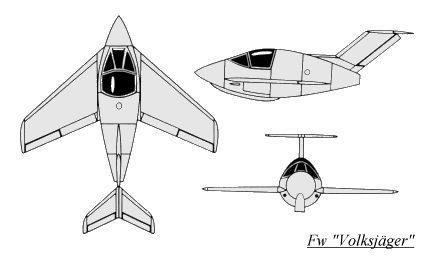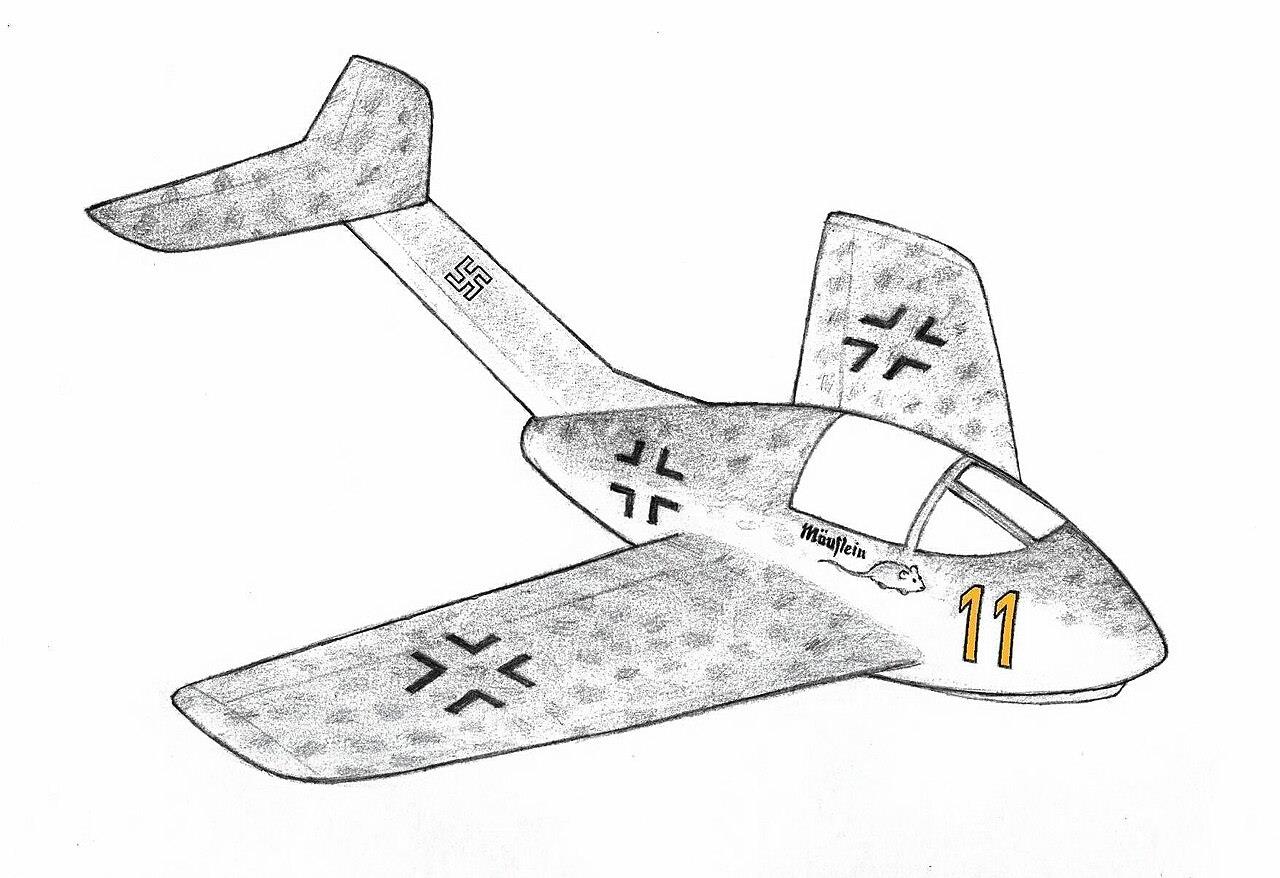The Focke-Wulf "Volksjäger" (People's Fighter) was based on the Ta 183, and was designed to be a target defense interceptor. Since the endurance was on the order of about 15 minutes, the "Volksjäger" would have had to be based near vital facilities, such as was planned for other Luftwaffe target defense fighters (e.g.. the Me 163 and the Ba 349). The "Volksjäger" had a mid fuselage mounted wing, and was sharply swept back. The wing's construction was to be of wood, with a thin metal covering and only weighed 180 kg . It also used a tail assembly very similar to the Ta 183, and the power was supplied by a single Walter HWK 109-509 A-2 rocket engine that produced 1700 kg of thrust. After a take off run (on a detachable dolly) of 257 m in 9.3 seconds, the "Volksjäger" would reach an altitude of 5900 m in 60 seconds and 16500 m in 100 seconds. It would then make its attack run, using two MK 108 30mm cannon located in the lower fuselage sides and then glide back to land on its retractable skid. Three aircraft were under construction when the war ended.
| Type |
Single seat target defense interceptor |
| Engine |
1 Walter HWK 109-509 A-2 |
1 BMW 003 A1 |
| Dimensions |
Length 5,3 m , height 2,7 m, span 4,8 m , wing area , |
Length 8,8 m , height 2,85 m , span 7,5 m , wing area 13,5 m2 , |
| Weights |
Empty 1800 kg, loaded , max. take off weight |
Empty , loaded 3050 kg , max. take off weight |
| Performance |
Max.. speed 1000 km/h , cruising speed , range , endurance , service ceiling , climb to 5900 m 60 sec. to 16500 m 100 sec. |
Max.. peed 820 km/h , cruising speed , range , endurance , service ceiling , climb to 5900 m 60 sec. to 16500 m 100 sec. |
| Armament |
2 30 mm MK 108 |


Volksjäger 1
The initial Volksjäger competition in the second half of 1944 required the use of the BMW 003 jet engine. The Focke-Wulf Volksjäger 1, the first model of the Focke-Wulf project, was an innovative-looking single-jet aircraft. It was designed to be powered by one BMW 003 A1 turbojet as an actual contract competitor to the Heinkel He 162A Spatz, the winner of the Volksjäger design competition and the selected Volksjäger aircraft to be mass-produced.
The air intake of the turbojet engine was placed in the front and the engine itself in the lower fuselage. Two possible shoulder wing configurations were designed for the Fw Volksjäger 1, straight and swept back. The wings of the swept back version spanned 7.5 m and had an area of 13.5 m2 . The tail was supported by a boom above the engine exhaust. It was planned to be armed with two 30 mm MK 108 cannon, placed in the front either side of the air intakes.
Volksjäger 2
Designed for early 1945 RLM requirements the Focke-Wulf Volksjäger 2 was a small rocket-powered interceptor. It had a wingspan of 4.8 m and a length of 5.3 m . Power was to be provided by a Walter HWK 109-509 A-2 rocket engine that would enable it to reach speeds nearing 1,000 km/h . Armament was to be two 30 mm MK 108 cannon located under the fuselage.
In order to save strategic materials, the wings of the Fw Volksjäger 2 were built of wood and covered with a thin metal layer. The wings, swept back and mounted on mid-fuselage, as well as the T-tail, were similar to those of the Focke-Wulf Ta 183. The aircraft had no wheels, only a landing skid. It was designed to take off on a detachable dolly. Once airborne it would speed almost vertically towards the bomber combat box formations where it would fire its cannon.
Although the Fw Volksjäger 2 was planned to reach an altitude of 5,900 m in one minute, its effectiveness as an interceptor was curtailed by the fact that it would have only about 15 minutes of combat action time. Test flights for this aircraft were scheduled to be carried out between May and June 1945. Three units of the Fw Volksjäger 2 were under construction at the time of the surrender of Nazi Germany.

